Beech Avenue, Thoresby
Above: Birklands Wood.
In the 19th Century the wooded areas of Birklands, around the Major Oak, and Bilhaugh, next to Ollerton Corner, were popular tourist attractions, both a part of Thoresby Estate. Birklands was landscaped and maintained with a mixture of Oak and Birch, and there is an interesting record of how a 1902 scheme to seed the area with new birch trees was thwarted by pre-myxomatosis levels of rabbit population, before which up to 10,000 rabbits had been shot annually on the estate.
The 20th Century took a toll on both the Bilhaugh and Ollerton Corner areas in particular. Timber was needed for two wars, not to mention the opening of a Colliery (the name of which was at first objected to by Thoresby Estate). In 1942 Proteus Camp (eventually re-named the Dukeries Training Area) was established, and both Birklands and the woods at Bilhaugh and Ollerton Corner, were used as ammunition dumps. During these decades the emphasis was clearly not on landscaping for leisure pursuits, but on hard core profitable production and National needs.
Beech Avenue.
These four rows of trees apparently rivalled Robin Hood's Major Oak as a place of both local and national interest. When in 1925 a railway track was planned to run from Thoresby Colliery, through Cockglode, and into Ollerton Corner, letters of protest appeared in The Times. Thanks to public support of Earl Manvers' petition the scheme was dropped. But the woods of Ollerton Corner were cleared for timber needed by the mine.
It is known that the war time entertainer Gracie Fields once visited Beech Avenue whilst staying at the Coaching House, now known as the Hop Pole. Beech Avenue acquired the nickname "the Cathedral" because of the way its branches met over the roadway like the arches over a cathedral's aisle. Allegedly, even at the height of summer, the only light which penetrated was from each end of the Avenue.
Beech Avenue was finally cleared in 1976 / 78, following decades of neglect, overgrowth, old age, the storm damage of 1976, and of course the military presence of Proteus Camp. But it is still clearly labelled on certain maps, and marked by an aging gate at the side of the A614 near Ollerton roundabout (although I believe it was situated a few yards to the right of that gate).
It is known that the war time entertainer Gracie Fields once visited Beech Avenue whilst staying at the Coaching House, now known as the Hop Pole. Beech Avenue acquired the nickname "the Cathedral" because of the way its branches met over the roadway like the arches over a cathedral's aisle. Allegedly, even at the height of summer, the only light which penetrated was from each end of the Avenue.
Beech Avenue was finally cleared in 1976 / 78, following decades of neglect, overgrowth, old age, the storm damage of 1976, and of course the military presence of Proteus Camp. But it is still clearly labelled on certain maps, and marked by an aging gate at the side of the A614 near Ollerton roundabout (although I believe it was situated a few yards to the right of that gate).
Above: The gate near Ollerton roundabout where Beech Avenue was once situated.
Chestnut Avenue.
From the north western end of Beech Avenue one could continue to Buck Gates and Chestnut Avenue. Chestnut Avenue was a straight carriage ride to the original Thoresby Hall (still visible from the air), and it is said that in the 18th Century one could view the Hall beside Thoresby Lake, from Buck Gates lodge.
Labels: Beech Avenue, Bilhaugh, Birklands, Ollerton, Sherwood Forest tourist attractions, Thoresby Colliery, Thoresby Estate



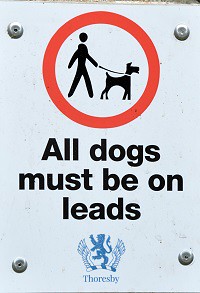 Thoresby Hall Hotel, Sherwood Forest and Clumber Park are recommended attractions for a day trip or short vacation. The
Dukeries area is of keen historic interest. NOTE: Apart from public domain postcards and brochures ALL photographs herein are copyright Ian Gordon Craig, exclusive permission granted to Thoresby Estate for their use elsewhere.
Thoresby Hall Hotel, Sherwood Forest and Clumber Park are recommended attractions for a day trip or short vacation. The
Dukeries area is of keen historic interest. NOTE: Apart from public domain postcards and brochures ALL photographs herein are copyright Ian Gordon Craig, exclusive permission granted to Thoresby Estate for their use elsewhere.
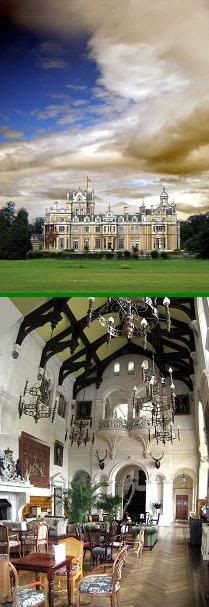 Thoresby Hall as photographed Summer 2009, now a successful Warners Hotel.
Thoresby Hall as photographed Summer 2009, now a successful Warners Hotel.
 Robert Pierrepont (1584 - 1643), 1st Earl of Kingston upon Hull, bought Thoresby for his second son William.
Robert Pierrepont (1584 - 1643), 1st Earl of Kingston upon Hull, bought Thoresby for his second son William.
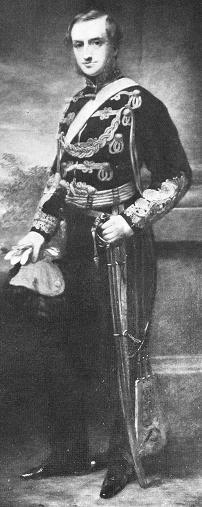 Sydney William Herbert Pierrepont (1825 - 1900), 3rd Earl Manvers, built the present Thoresby Hall, St John's Church,
Perlethorpe School, and generally shaped Thoresby Estate as it looks today.
Sydney William Herbert Pierrepont (1825 - 1900), 3rd Earl Manvers, built the present Thoresby Hall, St John's Church,
Perlethorpe School, and generally shaped Thoresby Estate as it looks today.
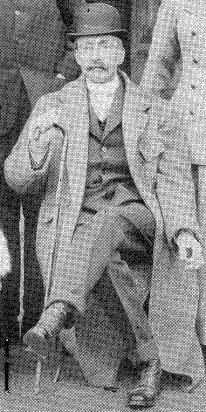 The 4th Earl Manvers (Died 1926).
The 4th Earl Manvers (Died 1926).
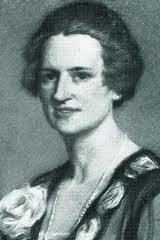 Countess Manvers (d.1984). Examples of her paintings are always on show at Thoresby Gallery.
Countess Manvers (d.1984). Examples of her paintings are always on show at Thoresby Gallery.
 ABOVE: The statue of Robin Hood in the courtyard at Thoresby Hall, by Tussaud - Birt, is showing its age, but remains one of
my favourites. The Art Gallery, crafts shops, and restaurant within that courtyard are recommended.
ABOVE: The statue of Robin Hood in the courtyard at Thoresby Hall, by Tussaud - Birt, is showing its age, but remains one of
my favourites. The Art Gallery, crafts shops, and restaurant within that courtyard are recommended.

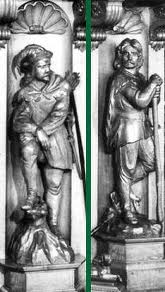
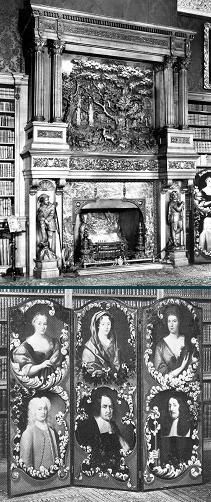 Carved oak fireplace in the Thoresby Hall library with its depiction of the Major Oak (Robin Hood's Tree), and the screen
featuring the Cromwell family. Oliver Cromwell is known to have stayed in Thoresby Hall before the English Civil War.
Carved oak fireplace in the Thoresby Hall library with its depiction of the Major Oak (Robin Hood's Tree), and the screen
featuring the Cromwell family. Oliver Cromwell is known to have stayed in Thoresby Hall before the English Civil War.
 The Green Bridge sited near the edge of the cricket pavilion in front of Thoresby Hall across which the Duke's carriage would take him to Perlethorpe Village.
The Green Bridge sited near the edge of the cricket pavilion in front of Thoresby Hall across which the Duke's carriage would take him to Perlethorpe Village.
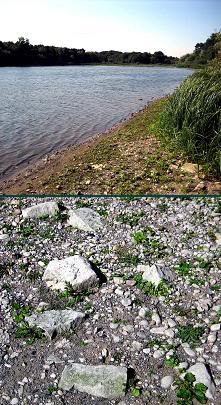 The view along Thoresby Lake towards Budby. Are these bricks at the water's edge remnants from the original Thoresby
Hall?
The view along Thoresby Lake towards Budby. Are these bricks at the water's edge remnants from the original Thoresby
Hall?
 The River Meden winds its way from 7 Ton Bridge near Thoresby Hall towards Perlethorpe Village.
The River Meden winds its way from 7 Ton Bridge near Thoresby Hall towards Perlethorpe Village.
 Budby Castle, once known as William Castle, and the River Meden winding towards Thoresby Lake under the remains of
Pierrepont Bridge, once described as classical and elegant.
Budby Castle, once known as William Castle, and the River Meden winding towards Thoresby Lake under the remains of
Pierrepont Bridge, once described as classical and elegant.
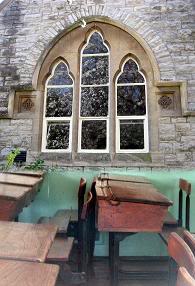
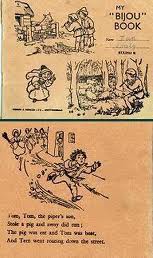 Children's exercise book from the school, 1958.
Children's exercise book from the school, 1958.
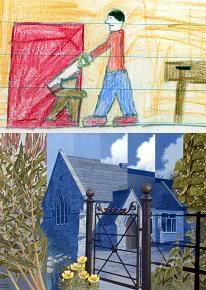
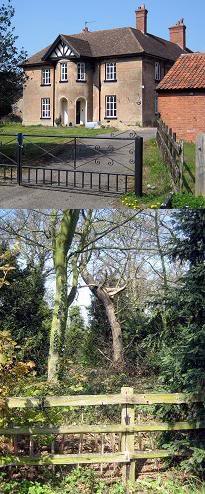



 Perlethorpe Church graveyard, where the original chapel once stood. The covered gate was a later addition in memorium to
the men of Budby and Thoresby who fell in World War 1.
Perlethorpe Church graveyard, where the original chapel once stood. The covered gate was a later addition in memorium to
the men of Budby and Thoresby who fell in World War 1.
 Robin Hood's Tree, the Major Oak, was once under the care and supervision of Thoresby Estate. Responsibility for its
upkeep changed to Nottingham City Council c.1969. Here it is pictured in in Spring, Autumn, and Winter.
Robin Hood's Tree, the Major Oak, was once under the care and supervision of Thoresby Estate. Responsibility for its
upkeep changed to Nottingham City Council c.1969. Here it is pictured in in Spring, Autumn, and Winter.

2 Comments:
Perlethorpe Village, Thoresby Park, Sherwood Forest, the Dukeries, Thoresby Hall, history.
Pierrepont, Manvers, Dukeries, Thoresby Hall, Thoresby Hotel, Thoresby Park, Perlethorpe, Perlethorpe Village, Ollerton, Budby, Sherwood Forest, Perlethorpe School, Perlethope Church, Budby.
Post a Comment
<< Home